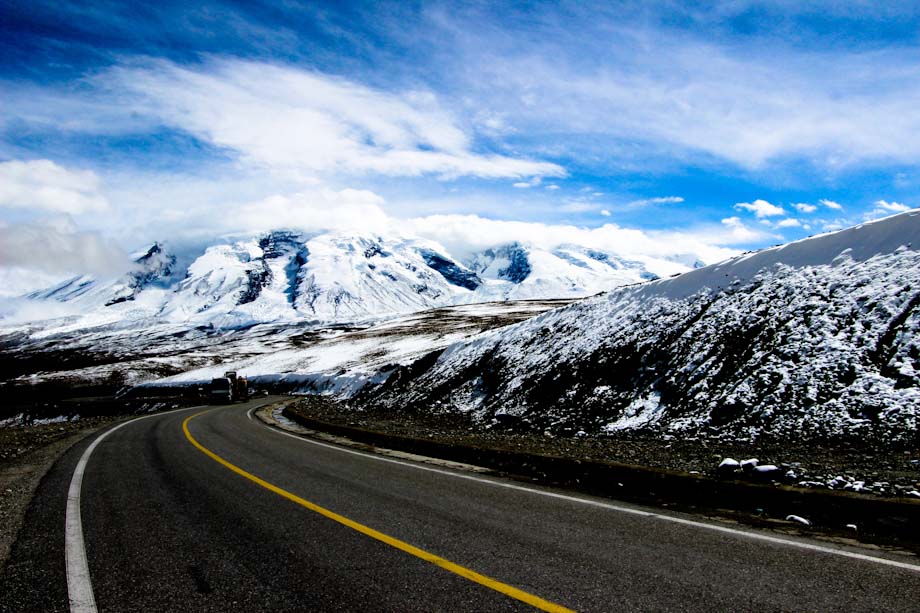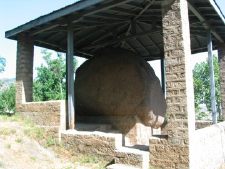The Karakoram Highway(KKH) is one of the highest paved international roads in the world.

The Karakoram Highway (often abbreviated to KKH and sometimes
transliterated as Karakorum) runs between Western China and
Pakistan . It is one of the very few routes
that cross the Himalayas and the
most westerly of them. Following the KKH is considered to be one of the classic
journeys of the travel world, it is also the highest international road in the
World.
Historically, this was a caravan trail, one branch of the ancient Silk Road. More recently, the Chinese
and Pakistani governments have built a highway.
It is the highest border crossing in the world, over 4800 meters
(roughly 16,000 feet) in the Khunjerab Pass at the border. For comparison, Mont Blanc, the tallest mountain in
Western Europe, is 4810 m and Mount Whitney, the highest point in the 48
contiguous United States, is 4421.

It may be the ultimate challenge for the devoted cyclist. There are
organised bicycle tours, and several books about bicycling this route.
Unfortunately the border is not open for cyclists. Everybody has to board the
bus in either Tashkurgan (China) or Sost (Pakistan). From the Pakistani side you
CAN cycle up to the pass, but not over it. You will have to return to Sost to
take the bus.

Choose your time carefully. The highway is open around the year, though the
tourist time is usually from May till late November and beware closures on
religious or public holidays. It's a tough terrain and expect landslides during
rainy season. Road condition is very good as the governments of Pakistan and
China have reconstructed the highway. It is not advisable to take cars, 4x4 is
preferred but a Van / coaster would serve the purpose. Besham is the start of
Kohistan which is famous for its ruggedness and stubbornness. It is highly
advisable to limit your stay and keep going preferably during day time. Kohistan
borders Baltistan which is relatively safe. Main town to stay overnight is
Chilas.
The KKH section from Besham to Gilgit is dry and warm. In summers, the
temperature may go as high as 40 Celcius (Chillas is known as Sibi of
Baltistan). Keep yourself well hydrated.
As of July 2013, there are two police checkpoints along the highway in China;
for those leaving Kashgar, the smaller one is before Karakol Lake, and a larger
one before Tashkurgan. These may slow down your journey significantly if there
are many cars and trucks.
The Pakistani section of the highway officially starts from Hasan Abdal, 60
kms from Islamabad. Chinese section starts from Kashgar, a major city in
Xinjiang Autonomous Region , 1479 kms from Urumqi.

The highway passes the Hunza
Valley The Hunza was the original Shangri La that inspired the novel (and
later movie). Hunza is known for its orchards, moderate Islam, welcoming
hospitality and beautiful scenery.
You can see in your way ............
- Uprising Memorial is a memorial dedicated to the people of Kashmir Valley who rose against Maharaja in 1947. It includes the graves of the local heroes, Mohammed Babar Khan and Safiullah Beg of the Gilgit Scouts, and Mirza Hassan Khan of the Kashmir Infantry.
- Ganish Village: The Village has been recenly restored and had already won a UNESCO Asia Pacific Heritage Award. Located in Hunza, Ganish shows traditional Hunza life. It includes several richly carved wooden mosques, 100 to 200 years old. Near to Ganish Village is Gulmit which is popular for Hunza's Mir Palace, a Cultural Museum and Marco Polo cafe. Also see Sacred Rocks of Hunza.
- Channel Walk: A three- or four-hour walk along the main water channels from Ultar Nala is a good way to see Hunza at its best. Try to avoid the delicate side channels.

- Queen Victoria Monument: The Queen Victoria Monument at the top of the rock face behind Karimabad can be reached in an hour from Baltit.

- Ashoka Rocks: On the north side of town is Mansehra's tourist attraction, three granite boulders on which 14 edicts were engraved by order of the Mauryan king Ashoka in the 3rd century BC.

- Italian K2 Museum: Located at PTDC K2 Motel, the museum was setup in 2004 to commemorate Italian expedition of K2 in 1954.

- Shigar Fort
- Khaplu Palace
Pakistan is one of the most peaceful region in the World so the travellers do not need to worry about the security there, you are free to go anywhere, Just avoid drinking the tap water use mineral water, If you are in upper Hunza (Gojal)then you can drink the tap water, its clear and it comes directly from the spring!
Have a nice journey..........




















